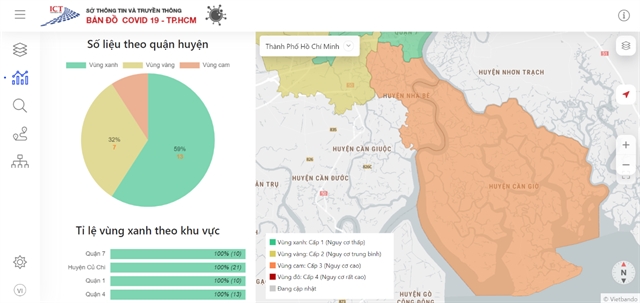 Society
Society

HCM CITY— In HCM City 13 out of 312 wards, communes and towns remained at ‘high risk’ of COVID-19 spread as of November 8, according to the Department of Health.

|
| The HCM City COVID-19 map shows Cần Giờ and Nhà Bè districts are at ‘high level’ of risk. Source baotintuc.vn |
HCM CITY— In HCM City 13 out of 312 wards, communes and towns remained at ‘high risk’ of COVID-19 spread as of November 8, according to the Department of Health.
But there are no restrictions on travelling there.
The city’s status in the four-level categorisation is ‘medium risk’.
Cần Giờ and Nhà Bè districts are at ‘high risk’ because they have people working in industrial parks and export processing zones, which have COVID-19 incidence.
Districts 3, 10, 12, Bình Tân, Bình Thạnh, Bình Chánh, and Hóc Môn are ‘medium’ and the remaining 13 are ‘low’.
Phạm Đức Hải, deputy head of the city Steering Committee for COVID-19 Prevention and Control, said there are 900-1,000 new COVID-19 cases every day.
City authorities have instructed the public to comply with preventive measures and regulations on vaccination, testing and quarantine.
With many people coming from outside testing positive, the city Department of Health has instructed relevant agencies and enterprises to monitor migrants closer to quickly detect COVID and prevent its spread.
Large-scale testing
According to the chairman of the People’s Committee, Phan Văn Mãi, the city plans to test on a large scale to assess the situation.
Four per 1,000 people are likely to be tested, and the city expects to test at least 6,000 every day.
The Department of Health has instructed districts and Thủ Đức City to do tests, but said they should do them only in wholesale and traditional markets, bus stations, supermarkets, social welfare centres, and others at high risk of COVID spread.
Others at risk like small merchants, salespeople, ticket salesmen, security guards, motorbike taxi drivers, delivery workers, and others in residential areas should be tested based on their existing plans, it said.
A plan on periodic testing envisages doing pooled PCR tests every month for these risk groups, 10 per cent of them if they live in low-risk areas, 20 per cent in medium-risk areas and 30 per cent in high- and extremely-high risk areas.
People who are vaccinated or have recovered from COVID in the last six months should only be tested if they have symptoms, live in areas where epidemiological investigation is required or extremely high-risk areas or if they are required to quarantine by authorities.
Home-based treatment
According to Nguyễn Hoài Nam, deputy head of the Department of Health, the city has 51,424 medicine bags containing fever reducers, vitamins, corticosteroids, and anticoagulants left to provide COVID-19 patients at home.
It plans to buy more medicines if it sees an increase in COVID-19 incidence.
It also has stocks of antiviral drug Molnupiravir and will buy further if needed.
At the peak of the outbreak, the city had nearly 550 mobile medical stations with assistance from military medical personnel to treat patients.
Though the number of patients is reducing, the stations should remain, he said. Each can treat 50-100 people at a time.
With the military personnel leaving, local authorities should get private and public hospitals to support the stations, he said.
The Department of Health has instructed local authorities and other relevant agencies to provide medicines for COVID patients in time and attend to all calls from patients, warning a failure to do so would be penalised.
Vaccination
HCM City, Đà Nẵng and the provinces of Quảng Ninh, Ninh Bình, Lào Cai, Thừa Thiên Huế, Cà Mau, Bình Dương, Vĩnh Long, Đồng Nai, Kiên Giang, and Sóc Trăng have started vaccinating children aged 12-17.
So far 92.3 million doses have been administered in the country, which has a population of 98 million. VNS